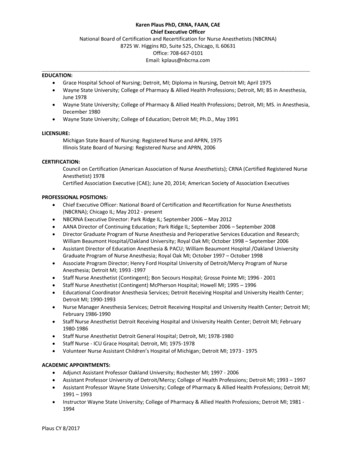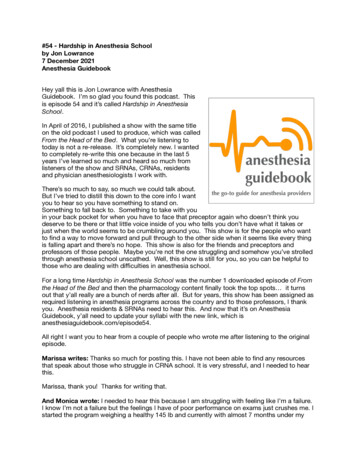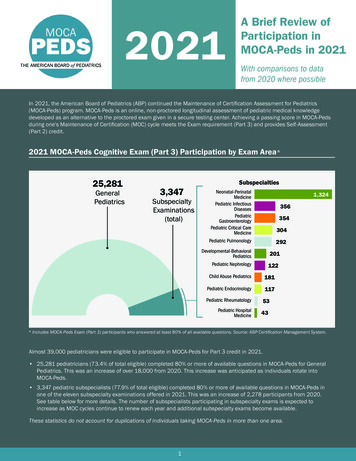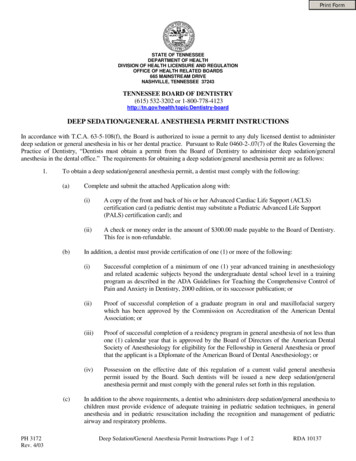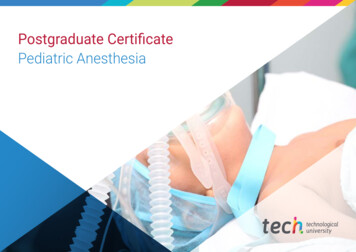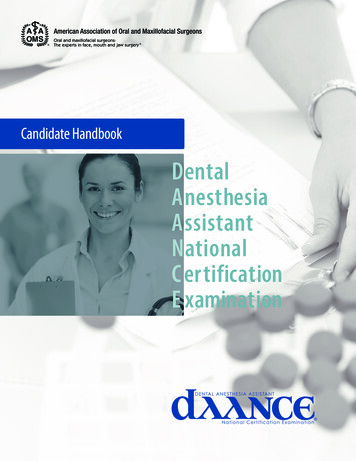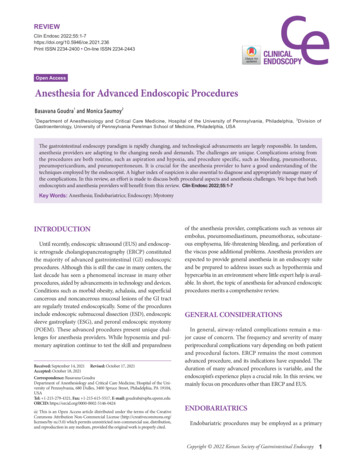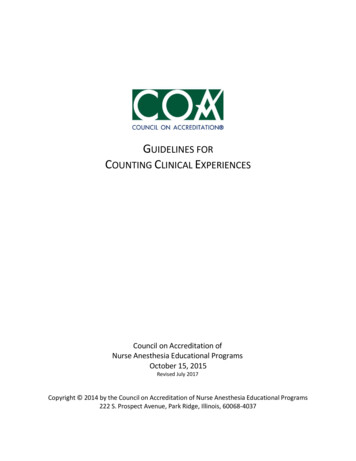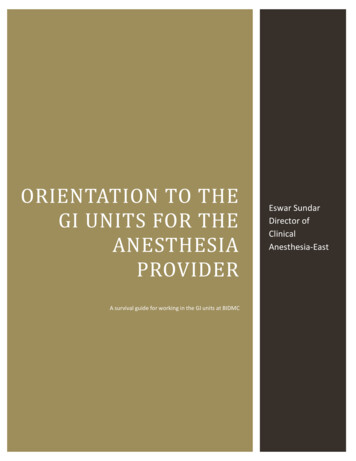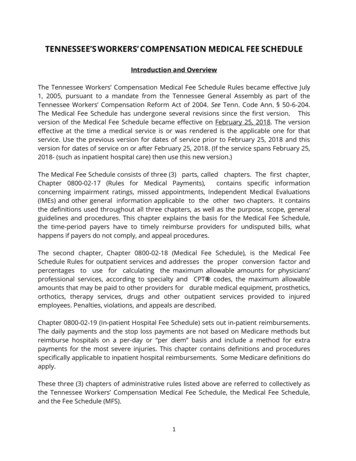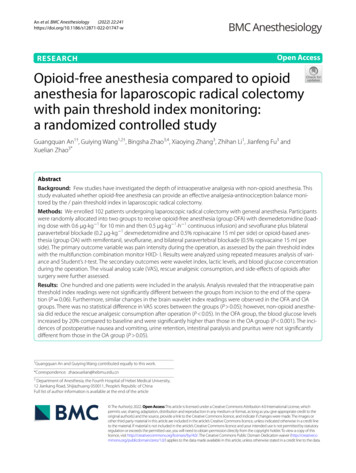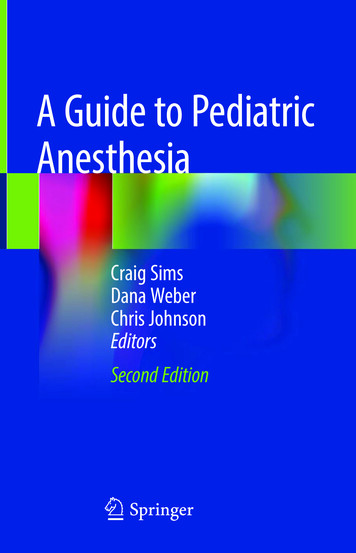
Transcription
A Guide to PediatricAnesthesiaCraig SimsDana WeberChris JohnsonEditorsSecond Edition123
A Guide to Pediatric Anesthesia
Craig Sims Dana Weber Chris JohnsonEditorsA Guide to PediatricAnesthesiaSecond Edition
EditorsCraig SimsDepartment of Anaesthesia and PainManagementPerth Children’s HospitalNedlandsWAAustraliaDana WeberDepartment of Anaesthesia and PainManagementPerth Children’s HospitalNedlandsWAAustraliaChris JohnsonFormerly Department of Anaesthesia andPain ManagementPrincess Margaret Hospital for ChildrenSubiacoWAAustraliaISBN 978-3-030-19245-7 ISBN -19246-4(eBook) Springer Nature Switzerland AG 2020This work is subject to copyright. All rights are reserved by the Publisher, whether the whole or part ofthe material is concerned, specifically the rights of translation, reprinting, reuse of illustrations, recitation, broadcasting, reproduction on microfilms or in any other physical way, and transmission or information storage and retrieval, electronic adaptation, computer software, or by similar or dissimilarmethodology now known or hereafter developed.The use of general descriptive names, registered names, trademarks, service marks, etc. in this publication does not imply, even in the absence of a specific statement, that such names are exempt from therelevant protective laws and regulations and therefore free for general use.The publisher, the authors, and the editors are safe to assume that the advice and information in this bookare believed to be true and accurate at the date of publication. Neither the publisher nor the authors or theeditors give a warranty, expressed or implied, with respect to the material contained herein or for anyerrors or omissions that may have been made. The publisher remains neutral with regard to jurisdictionalclaims in published maps and institutional affiliations.This Springer imprint is published by the registered company Springer Nature Switzerland AGThe registered company address is: Gewerbestrasse 11, 6330 Cham, Switzerland
Ten Current Issues in Pediatric Anesthesia andWhere to Find Them1. Emergence DeliriumYoung children sometimes wake from anesthesia crying and unhappy. Thereare many reasons for this, although sevoflurane dysphoria is commonly blamed.See Chap. 2.2. The Uncooperative ChildMany children become anxious during induction of anesthesia, and their anxiety may cause them to become uncooperative. There are many ways to reducechildren’s anxiety. See Chap. 3.3. VideolaryngoscopesMany types of videolaryngoscopes are now available in sizes suitable for children. Their use is being informed by new studies, including the PediRegistrystudy of difficult airway management in children. See Chap. 4.4. Reducing Perioperative Respiratory ComplicationsRespiratory complications are the leading cause of morbidity in pediatric anesthesia, and there has been a surge in studies looking at the risk factors for themand how to modify the risk. See Chap. 11.5. Shorter Fasting Times for Clear FluidsIt is now realized clear fluids leave the stomach quickly, and allowing them upto 1 h or less before anesthesia has become common. See Chap. 5.6. Neurotoxicity of Anesthetic AgentsThere is laboratory evidence that many anesthetic agents, including volatiles,affect the developing brain of neonates. See Chap. 2.7. The AirwayMany anesthetists do not like caring for children because of difficulties managing the pediatric airway. See Chap. 4 for many practical tips.8. RSI and Cricoid PressureThe adult technique of rapid sequence induction is dangerous if directly appliedto young children. There are calls to abandon the technique and cricoid pressurealtogether. See Chap. 1.v
viTen Current Issues in Pediatric Anesthesia and Where to Find Them9. Reducing Pain and Distress During ProceduresHolding a child down to perform a procedure is becoming less and less acceptable. Many techniques and drugs are now used to make procedures more comfortable and less distressing for the child, parents, and staff. See Chap. 27.10. Hypotonic IV Fluids for ChildrenHypotonic, dextrose-containing solutions have been traditionally used for IVfluids in children. The risk of hyponatremia from these fluids is so high thatsalt-rich fluids are recommended nowadays. See Chap. 5.
Useful Formulae in Pediatric Anesthesia WeightBody weight for infants (age in months/2) 4 kg (APLS)Body weight for children 1–10 years (age 4) 2 kg (UK ResuscitationCouncil)Body weight for children older than 10 years age 3.3 kg (large variation innormal adolescent weight however) (APLS) Blood PressureExpected systolic blood pressure for children older than 1 year 80 (age inyears 2) mmHg. FluidsMaintenance fluid rate in mL/h: (4:2:1 rule)4 mL/kg first 10 kg weight 2 mL/kg next 10 kg weight 1 mL/kg for rest ofweight (e.g., for a 19 kg child: (10 4) (9 2) 58 mL/h).Minimum 10% dextrose infusion for neonate day one (4 mg/kg/min) inmL/h 2.5 weight in kg (e.g., 3 kg neonate needs at least 7.5 mL/h 10%dextrose) ETT SizeUncuffed ETT size for a child over 2 years: Age/4 4 ETT size (inside diameter,mm) (modified Cole formula)Cuffed ETT size for a child over 2 years: Age/4 3.5 ETT size (ID, mm)(Motoyama formula)vii
viiiUseful Formulae in Pediatric Anesthesia ETT DepthPosition at vocal cords ID size of ETT (e.g., 4.5 ETT should be 4.5 cm at vocalcords)Oral ETT length (at lips in cm) age/2 12Nasal ETT length (at nostril in cm) age/2 15 (and diameter of correct-sizenasal ETT same as oral ETT for children)Neonates: Oral ETT length (at lips in cm) weight(kg) 6Neonates: Nasal ETT length (at lips in cm) (weight(kg) 1.5) 7 Suction Catheter for ETTSize of suction catheter for ETT (in French Gauge) 2 size of ETT (ID) Urinary CatheterUrinary catheter size (FG) 2 size of ETT (ID) CVCDepth for central line placement in right IJV 10% of height (e.g., 8 cm in an 80 cmlong child)
Contents1 An Overview of Pediatric Anesthesia 1Craig Sims and Tanya Farrell2 Pharmacology of Anesthetic Agents in Children 27Craig Sims and John Thompson3 Behavioral Management of Children 55Craig Sims and Lisa Khoo4 Airway Management in Children 77Britta von Ungern-Sternberg and Craig Sims5 Fluid Management in Children Undergoing Surgeryand Anesthesia 115Ric Bergesio and Marlene Johnson6 Equipment and Monitoring for Pediatric Anesthesia 135Craig Sims and Tom Flett7 Resuscitation and Emergency Drugs 155Philip Russell8 Crises and Other Scenarios in Pediatric Anesthesia 181Tom Rawlings and Tom Flett9 Acute Pain Management in Children 199Priya Thalayasingam and Dana Weber10 Regional Anesthesia for Infants and Children 221Chris Johnson and Chris Gibson11 Respiratory Illnesses and Their Influence on Anesthesiain Children 241Britta von Ungern-Sternberg and David Sommerfield12 Chronic Disease of Childhood 259Alison Carlyle and Soo-Im Limix
xContents13 Congenital Syndromes and Conditions 281Prani Shrivastava and Dana Weber14 Neonatal Anesthesia 287Chris Johnson and Dan Durack15 Anesthesia for Pediatric General Surgery 315Claudia Rebmann16 Anesthesia for Ear, Nose and Throat Surgery in Children 335Ian Forsyth and Rohan Mahendran17 Bronchoscopy and Removal of Foreign Bodies fromthe Trachea 351Marlene Johnson and Craig Sims18 Anesthesia for Dental Procedures in Children 365Lisa Khoo19 Anesthesia for Orthopedic Surgery in Children 373Martyn Lethbridge and Erik Anderson20 Congenital Heart Disease 381Serge Kaplanian21 Anesthesia for Thoracic Surgery in Children 397Neil Chambers and Siva Subramaniam22 Anesthesia for Plastic Surgery in Children 405Rohan Mahendran23 Pediatric Neuroanesthesia 411Mairead Heaney24 Anesthesia for Ophthalmic Surgery 421Elaine Christiansen25 Trauma and Burns 427Mary Hegarty26 Malignancy and Treatment of Malignancies in Children 443Bruce Hullett27 Procedural Sedation: Anesthesia and Sedation of ChildrenAway from the OR 453Tanya Farrell28 Central Venous and Arterial Access for Children 465Neil Chambers and Yu-Ping Chen29 The Child at Risk: Child Protection and the Anesthetist 475Craig Sims and Dana Weber
Contentsxi30 Pediatric Intensive Care 479Daniel Alexander31 A Selection of Clinical Scenarios 493Dana Weber and Craig Sims32 Glossary of Syndromes and Diseases 503Charlotte Jorgensen33 Short-Answer Questions from Past FANZCAand FRCA Examinations 515Craig Sims Index 521
1An Overview of Pediatric AnesthesiaCraig Sims and Tanya Farrell‘Pediatric’ or ‘child’ applies to someone aged less than 18 years. The AmericanAcademy of Pediatrics defines ‘pediatric’ as less than 21 years, while some centersuse 16 years. An infant is a child aged between 1 and 12 months. The term ‘neonate’applies to the first 4 weeks of life. Children make up a quarter of the population inmost Western countries and a higher proportion in developing countries. Pediatricanesthesia is very common—5.5% of children have an anesthetic each year, andabout half are preschool age. The commonest indication for anesthesia is ENT surgery, but children often need anesthesia for procedures such as scans and dentaltreatment that an adult would tolerate without anesthesia.Pediatric anesthetists have several special attributes described by the late Dr.Kester Brown: they have expertise in caring for neonates and infants during anesthesia and surgery; they understand the anesthetic implications of congenital diseaseand disability; and they have knowledge of the psychological, physiological, pharmacological and anatomical differences with age.1.1 Safety of Pediatric AnesthesiaAnesthesia for children has become very safe. Parents can be reassured that the profession has taken many steps over the years to reduce risk. These steps include analysis of past incidents (anesthesia was the first specialty to perform incident monitoring),embracing new monitoring technologies, improved specialist training and takingC. Sims (*) T. FarrellDepartment of Anaesthesia and Pain Management, Perth Children’s Hospital,Nedlands, WA, Australiae-mail: craig.sims@health.wa.gov.au; Tanya.Farrell@health.wa.gov.au Springer Nature Switzerland AG 2020C. Sims et al. (eds.), A Guide to Pediatric -4 11
2C. Sims and T. Farrelladvantage of safer drugs. The overall mortality from anesthesia alone in a healthy,older child is approximately 1 in 50,000 to 1 in 100,000. Tertiary pediatric centersreport overall mortality at 24 h after anesthesia and surgery at about 13 per 10,000anesthetics. Anesthesia-related mortality in this group is reported as 0.7 per 10,000.Morbidity is common with anesthesia in children. More than half of critical incidents are respiratory incidents and are mostly airway related such as laryngospasm,bronchospasm, hypoxia, and hypoventilation. The risk increases with decreasingage, because of smaller airway diameter and a predisposition to develop apnea andairway obstruction from airway irritation (Fig. 1.1). Infants and young children alsodesaturate rapidly. Children 3 years and younger have a higher risk than older children. Infants are particularly at risk, with critical incidents four times more likelycompared to older children. Surveys show critical incidents (again most commonlyrespiratory) occurring in 3–5% of infants. Risk is also increased by underlyingpathology including congenital disease, the urgency of the procedure, and the hospital setting (Table 1.1).6Incidence of critical respiratory event (%)Fig. 1.1 The incidence ofcritical respiratory events(those requiring immediateintervention and that led(or could have led) tomajor disability or death)during anesthesia inchildren of different agegroups. Based on data fromAPRICOT study, LancetRespir Med 2017;5:412–2542 1 1 2 3 4 5 6 7 8 9 10 11 12 13 14 15Age (y)Table 1.1 Patient, surgical and anesthetist factors that may increase the risk of anesthesia inchildrenFactors increasing risk of morbidity and mortalityHigh riskAgeNeonates, infantsASA status3–5SurgeryEmergency surgeryExperience of theanaesthetistMedium risk1–3 years2 (includes recentURTI)Airway and dentalsurgeryLow risk 3 years1Cardiothoracic, neurosurgery,Peripheral, minorscoliosis surgerysurgeryIncreases riskIncreased risk with small case load of children of similar age to patient
1An Overview of Pediatric Anesthesia3KeypointMost critical incidents are respiratory and airway related. Proficiency in airway management is the cornerstone of safe pediatric anesthesia practice.The risk of morbidity is lower if the anesthetist is experienced and has a largepediatric case load (Table 1.2). Although there are no formal requirements for anesthetists caring for children, it is generally agreed that practitioners anesthetizingchildren aged 3 years and less should regularly anesthetize this age group, and anesthetists caring for children aged less than 1 year should regularly anesthetize infants.Neonatal anesthesia should be performed by those who have a fellowship in pediatric anesthesia.KeypointChildren aged less than 3 years, and especially aged less than 1 year are at ahigher risk from anesthesia than older children.1.2 Organization of ServicesIf you are anesthetizing a child in a non-pediatric hospital it is important to makesure it is safe to do so. Several factors determine if a child can be safely cared for ata particular facility. Broadly, there are factors relating to the patient and the type ofsurgery planned (Table 1.3), and factors relating to the hospital such as the level ofstaffing, equipment and facilities (Table 1.4). An older child undergoing day staysurgery has different health facility requirements compared with an infant withcoexisting medical problems requiring overnight admission after surgery.The Australian and New Zealand College (ANZCA) guideline PS29 (2019) andthe United Kingdom College guidelines (2018) discuss staffing for the care of children in non-pediatric hospitals. These policies particularly apply to infants and neonates because of their greater risk. Anesthetists looking after children should haveTable 1.2 The pediatriccaseload of the anesthetistaffects the rate ofcomplicationsNumber of anesthetics given per year1–100 children100–200 childrenMore than 200 childrenComplications7/10002.8/10001.3/1000Based on Auroy and Ecoffey, Anesth Analg 1997Table 1.3 Patient factors to consider indetermining level of staff and facilities needed tosafely care for childrenPatient factorAge of child, esp. if 12 monthsType of surgeryASA status/General health of the childOvernight admissionEmergency procedure
4C. Sims and T. FarrellTable 1.4 Summary of requirements to safely anesthetize children (based on ANZCA PS29 andRCOA guidelines)Organization of servicesStaffExperience and case load to maintain competency in relevant ages and casemix of: anesthetist assistant recovery ward nursesEquipment In addition to equipment and facilities needed to safely anesthetize adult patients: Size-appropriate breathing circuit, airway equipment and monitoring Anesthetic machine and ventilator suitable for ages of children beinganesthetized Suitable fluid administration devices (may include burette) Resuscitation drugs and equipment (including defibrillator and pads suitablefor children) Ability to control temperature of OR Beds and cots suitable to contain child and prevent fallsFacilitiesAbility for parents to accompany child to theater and be present in recoverySeparated areas from adults-wards, OR, PACUAccommodation for parents if overnight admissionLinks to tertiary pediatric centers for advice and transfer of patients ifpostoperative problems occurPharmacy knowledgeable in pediatric dosesAcute pain service, HDU/ICU if relevant to case-mixGovernance Local hospital group with oversight of scope of practice and suitability of staffinvolvedLocal protocols and regulations for selection of patients and aspects of their careGradual implementation of any changes and ongoing quality assurancetraining in the relevant age group, and should not anesthetize children if they are notcomfortable to do so due to either lack of recent experience or inadequate case load.Having a second anesthetist to help should be considered for infants and childrenASA3 status or higher. The anesthetic assistant and perioperative staff should havetraining in the care of children. Not all children can be cared for in tertiary children’s hospitals, so most countries have networks in which information, guidelinesand training are exchanged between central specialist and peripheral general hospitals. As part of this, there is generally a lead consultant to oversee provision ofpediatric anesthetic services in general hospitals.1.3 Preoperative AssessmentAs in adults, assessment of children before anesthesia includes a history and examination, aiming to assess previous anesthetic problems and the severity of co-existingdiseases. It is also an opportunity to establish rapport with the child and parents,assess the child’s behavior and reassure the parents with your manner and professionalism. Most children are healthy and active, although there is always the possibility of an unrecognized abnormality or syndrome. Some children have dysmorphic
1An Overview of Pediatric AnesthesiaTable 1.5 Facial dysmorphic features thatmay indicate a congenital syndrome5Dysmorphic featureWidely spaced eyes (hypertelorism)Beaked or other nose abnormalityLow hairline on foreheadLow slung or malformed earsCraniosynostosisMicrocephalyfeatures suggesting an underlying syndrome (Table 1.5). If a child has one congenital malformation it is more likely that there will be another. Common conditions tospecifically ask about include preterm delivery, recent upper respiratory tract infection, obstructive sleep disorder, developmental concerns and bleeding disorders.Examination needs to take into consideration the modesty of the child, particularly with school-aged children and adolescents. Examination may occasionallyreveal a previously unrecognized heart murmur (see Chap. 20, Sect. 20.3.1), signs ofasthma or URTI (see Chap. 11, Sects. 11.2 and 11.3), or loose teeth. The most important aspect of airway assessment is mandibular size (see Chap. 4, Sect. 4.2).Investigations such as hemoglobin, CXR and urinalysis are not routinely performedin healthy children undergoing minor surgery. Hemoglobin is not tested because significant anemia is rare in children and mild anemia does not affect the decision toproceed with anesthesia. Some centers use the Sickledex test in patients at risk ofsickle cell anemia.Pre-anesthetic clinics are not always used for healthy children. Clinics areunlikely to reveal significant medical problems, are inconvenient for the family, anddo not influence the most likely reason for cancellation of surgery, which is a viralillness just before surgery. Assessment is commonly by a telephone interview beforeadmission and review by the anesthetist on the day of surgery. However, thisapproach reduces the time available for informed consent for anesthesia.1.3.1 Loose TeethChildren lose deciduous teeth from 5 years of age. A very loose tooth may dislodgeand be aspirated during anesthesia and is sometimes removed (with parental permission) after induction. The tooth needs to be very loose before trying this, and usuallyhas no visible root (it is resorbed). If the tooth is not very loose it can be surprisinglydifficult and unpleasant to remove, and the gum may bleed. A tooth that is not on theverge of falling out can be watched carefully during airway manipulation andchecked at the end of the case to make sure it has not been dislodged.1.4 ConsentThe legal age for consent is usually between 16 and 18 years, depending on thejurisdiction. Consent for a child is therefore obtained from the parent or legal guardian. However, there is growing recognition of the rights of younger people. It is
6C. Sims and T. Farrellusual to at least obtain the assent (permission) to proceed with anesthesia and surgery in older school aged children, even though they may not be able to give legalconsent. Further complicating this area is the increasing recognition by courts ofchildren’s abilities to make their own decisions about treatment. Some health areashave policies in place that allow children as young as 14 years to consent to treatment. However, these policies are not a replacement for laws and it is still usual toobtain parental consent when the child is younger than 16–18 years.Young people at 16 years of age have the legal ability in most countries to makedecisions about their own care, and they must be presumed to be competent to makesuch decisions unless it can be shown otherwise. A valid refusal of surgery by achild who is competent should usually be respected. Legal advice should be soughtif the procedure is felt to be in their best interests despite their refusal, especially ifthe refusal of treatment could result in death or serious harm.Children younger than 16 years can consent if they demonstrate Gillick- competency. The Gillick competency test establishes the legal principles to decidea child’s ability to make health care decisions. The Gillick case considered consentfor prescription of the oral contraceptive to a 16 year old girl, and whether or not aparent’s permission was required. The findings of this case have been used to determine consent issues in general. For a child to be deemed competent to decide abouttheir healthcare they must have the ability to understand the factual, moral and emotional consequences of their decision. Competence is not reliant on a fixed age, andcompetence for one situation does not imply competence for all. The child’s age isstill considered—the younger the child, the less likely the child can understand theimplications of their decision and be considered Gillick-competent.KeypointAlthough some adolescents are mature enough to consent to anesthesia andsurgery, it is wise to obtain the parent’s consent in most perioperativesituations.In certain life-threatening circumstances, society allows the wishes of a child orthe parents to be overridden. This is firstly because a child is unlikely to competently rationalize life and death decisions, especially when they are so easily influenced by authority figures. Secondly, society is unwilling to allow any person tomake life and death decisions for someone else, including one’s own child. Hencelaws make it possible in an emergency to override the wishes of a person aged lessthan 18 years. The exact legal mechanisms for this vary between jurisdictions, andthe involvement of the hospital’s medical administrator is usual. These emergencyprovisions only apply if the procedure is critical and life-saving—a blood transfusion in severe hypovolemic shock may be permitted, but not force feeding ananorexic child who is not critically ill. As a practical matter, it is best to negotiate acompromise before proceeding to the courts for permission. Consent to treatment is
1An Overview of Pediatric Anesthesia7more likely to be given when the child’s and parent’s wishes and concerns areconsidered.Fortunately for pediatric anesthetists, consent issues are usually resolved by thetime a child presents for surgery. However, consent issues for anesthetists may ariseat the time of induction—is it reasonable to proceed when the child withdraws theirhand from the IV cannula, or pushes away the facemask? Children older than about8–10 years who are developmentally normal probably should not be restrained. Fearis often a large part of the child’s refusal, and this can be allayed with discussion,parental involvement, involvement of play therapists in children having many anesthetics, and pharmacological premedication if agreed. Younger children are probably not able to understand the importance of their treatment and it may be reasonableto restrain the child and proceed if other strategies fail. Supervising the parent tohelp restrain a younger child can help parents to accept this course of action.Although restraining a 2 or 3 year old child is straightforward and not uncommon,restraining a young school-aged child is unpleasant for the child, parent and staff,and should be avoided as much as possible by paying attention to the behavioralmanagement aspects of the child. The age beyond which restraint is not reasonabledepends on many surgical, patient, practical, societal and reality factors. A greatdeal of judgement is involved from case to case. Sometimes during induction, adecision must be made quickly to take one path or another before the child’s cooperation deteriorates further.1.4.1 Blood Transfusion in a Jehovah’s Witness ChildA blood transfusion critical to survival of the child (usually as determined by morethan one doctor) can be given legally without the consent of the parents. In fact,doctors have a legal obligation not to allow a child to die by withholding treatment.In the elective situation, children older than 14–16 years may be able to refuse atransfusion themselves, but the legality of this would need to be determined beforeproceeding with surgery.When a child’s parents refuse permission for a blood transfusion, they are usually only trying to do what is best for their child. Indeed, anesthetists should betrying to minimize blood transfusion in every child-there are many risks of transfusion, and children have a long life ahead for these risks to become apparent.Confrontation over this issue can be minimized by listening to the parents, tellingthem all the things that you will do to try and avoid blood products, and telling themthat you are legally obliged not to let their child die. There is no need to force parents to explicitly agree with this plan and thus refute their own beliefs. There is alsolittle to be gained from a confrontation with parents who are under stress about theirchild’s anesthesia and surgery when the likelihood of transfusion is extremely low.As medical providers, the legal obligation is straightforward and most parents areaware of this. Ongoing argument serves only to put parents and sometimes the childunder further stress.
81.5C. Sims and T. Farrell Intravenous AccessA short 24G or 22G cannula in the dorsum of the hand is the commonest method ofsecuring IV access in children. The finer 24G cannula may be more difficult toinsert, but it is less likely to be felt by the child. The lack of feeling may allow asecond attempt to insert the IV if the first attempt failed. The 24G cannula is theusual size for neonates and small infants, but in older children it tends to kink whenthe child moves post op.1.5.1 Positioning of the Awake Child for IV AccessTapes and equipment should be prepared before inserting the cannula to facilitatequick fixation, as the child may move and dislodge the cannula. If the child lies onthe bed, blankets can be placed to hide their hand and restrict movement. Youngerchildren can also sit across the parent’s lap, with the child’s arm brought under theparent’s arm (Fig. 1.2). This position hides the hand from the view of the child andparent and helps to keep the hand still by placing the child at a mechanicaldisadvantage.1.5.2 AssistanceA good assistant is vital to maximize the chances of successful venipuncture. Justusing a tourniquet for a young child is unlikely to work. It is important that theassistant holds the child’s hand and arm correctly, aiming to distend the veins andprevent withdrawal of the child’s hand. The assistant needs to hold the forearm tightenough to act as a tourniquet, but not so tight that the hand turns white from arterialcompression. The assistant also gently retracts the child’s skin up the limb, whichhelps to fix the vein. The assistant’s other hand can be placed across the child’selbow joint, which helps prevent sudden limb movement if the child feels the needle(Fig. 1.3). The anesthetist can stabilize their own arm by resting t
Cuffed ETT size for a child over 2 years: Age/4 3.5 ETT size (ID, mm) (Motoyama formula) viii ETT Depth Position at vocal cords ID size of ETT (e.g., 4.5 ETT should be 4.5 cm at vocal . Suction Catheter for ETT Size of suction catheter for ETT (in French Gauge) 2 size of ETT (ID)
